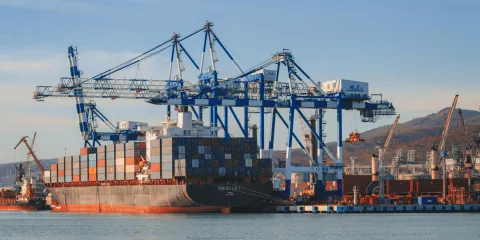AI innovation at UBCO helps shipping ports see what’s coming—literally
New technology improves forecasting, can help ports adapt quickly to global trade disruptions

A UBC Okanagan research team has developed an innovative artificial intelligence system that can accurately predict where ships are heading and arriving, potentially helping Canadian ports better prepare for incoming vessels and respond more efficiently to global supply chain disruptions.
Dr. Zheng Lui, a Professor with UBCO’s School of Engineering, and doctoral student Chengkai Zhang have created TrajReducer, a framework that increases prediction accuracy and computational efficiency by analyzing ship trajectories through advanced spatial clustering and cross-dimensional metadata ranking.
The research, published recently in Ocean Engineering, addresses a critical need in maritime logistics where accurate predictions of a vessel’s arrival time are essential for improving port operations, says Dr. Lui.
“Maritime shipping represents more than 80 per cent of global trade and the ability to accurately predict where cargo vessels are headed and when they will arrive, has never been more important,” he says. “Recent years have shown us how quickly global supply chains can be disrupted—whether by pandemic-related delays, geopolitical tensions or incidents like a shipping container getting stuck in the Suez Canal for several days. Canadian ports need tools to help them adapt quickly and efficiently.”
Traditional methods for predicting where ships are going have been slow and often inaccurate, he says, with about 30 per cent of data omitting the ship’s estimated time of departure and arrival.
TrajReducer solves these problems by studying patterns from several thousand ship voyages and using details about each vessel, such as its type, size, speed and direction.
“It is similar to having a smart GPS that not only knows where you’ve been, but can also predict where you’re going based on your driving patterns and what kind of car you drive,” explains Dr. Lui. “Instead of checking every single ship journey in our database, TrajReducer quickly identifies the most similar past voyages, including vessel size and weather conditions, to make its prediction.”
The system works by looking at a ship’s current path and comparing it to carefully chosen similar voyages. This provides a calculation of where a ship is headed with high accuracy, even early in its journey.
The technology has particular relevance for Canada’s major ports, including Vancouver, Prince Rupert, Montreal and Halifax which serve as critical gateways for North American trade, says Dr. Lui.
“Canadian ports handle hundreds of millions of tonnes of cargo annually, and even small improvements in operational efficiency can translate to significant economic benefits,” he adds. “When a port knows days in advance when a large container ship is arriving, staff can optimize berth assignments, arrange the right equipment and coordinate with rail and trucking networks.”
All of these steps can speed up delivery of the products in the shipping containers.
Compared to existing prediction models, TrajReducer’s efficiency and reliability offer significant advancements in maritime operations, as it allows for the accurate prediction of vessel destinations without extensive computational requirements.
“The beauty of this system is that it becomes more accurate as it processes more data,” adds Zhang. “As global shipping patterns evolve—whether due to new trade agreements, infrastructure changes or climate considerations—TrajReducer adapts and improves its predictions.”
This research represents a significant advancement in maritime analytics, with potential applications extending beyond port operations to include maritime safety, environmental monitoring and supply chain optimization.
“This is about more than efficiency—it’s about resilience,” says Zhang. “When Canadian ports can anticipate and prepare for the arrival of ships accurately, they’re better positioned to maintain the flow of goods that Canadians depend on, even when global trade faces unexpected challenges.”



